Sharing the scientific name Carassius auratus with other goldfish, Shubunkins set themselves apart with their calico patterns.
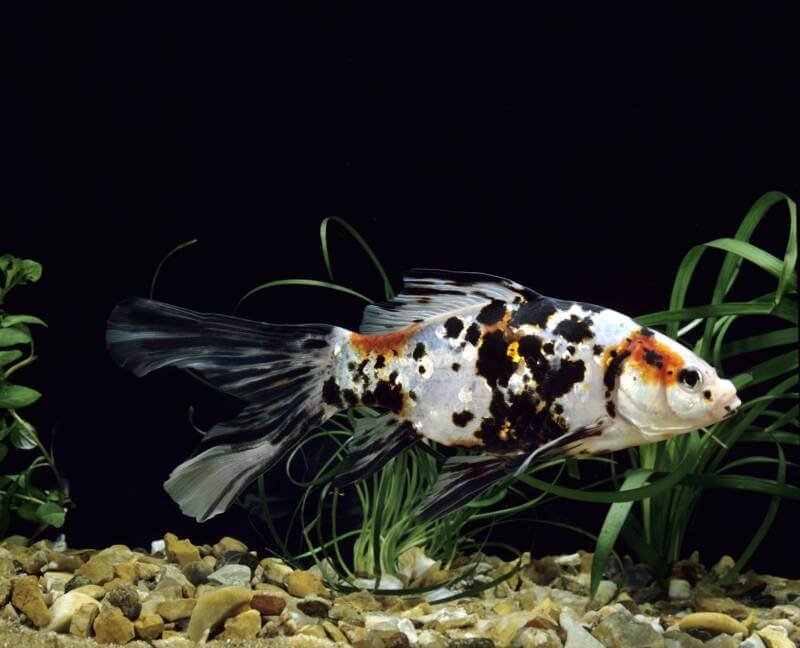
Similar to the marbling pattern seen in koi, aquarists enjoy adding them to community aquariums as a smaller “koi” option.
They’re hardy fish, withstanding near-freezing temperatures and less than optimal water conditions (though that shouldn’t be a goal).
As such, they do equally well in tanks and outdoor ponds. They’re undemanding in their needs, appealing to aquarists of every level.
At a Glance
| Tank size: | 75 gal (340 l) |
| School size: | can do well in pairs |
| Temperature: | 65-72°F (18-22°C) |
| Lifespan: | 10-15 years |
| Size in a tank: | 5-6″, 13-15 cm |
| Size in a pond: | 12-14″, 30-35 cm |
| pH: | 6.0-8.0 |
| Hardness: | 5-19 dH |
| Ammonia: | 0 ppm |
| Nitrite: | 0 ppm |
| Nitrate: | <40 ppm |
In this article
- In the Wild
- Types of Shubunkins
- Reds, and Golds, and Blues
- Size
- Lifespan
- Behavior
- Tank and Pond Setup
- Water Conditions
- Decorating the Shubunkin Pond or Tank
- Shubunkin Goldfish in Communities
- Feeding Your Shubunkin Goldfish
- Shubunkin Goldfish: Egg-Layers
- Male or Female?
- Breeding
- Health and Disease
- Shubunkin Goldfish: Are They for You?
In the Wild

Goldfish descend from the Prussian carp (Carassius gibelio). However, the Shubunkin type originated in Japan in the 1500s.
The popular calico pattern spread across Europe throughout the 17th century, reaching the United States by the 1800s.
Wild goldfish – which don’t share the calico marbling of Shubunkins – prefer slow-moving streams, ponds, and ditches.
They don’t have the bright colors of even the common goldfish, adopting more drab bronzes and silvers.
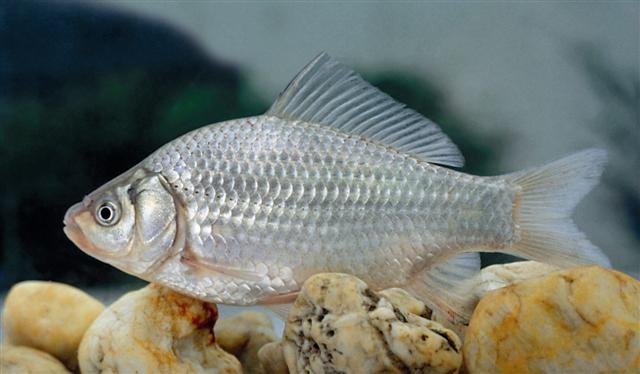
Types of Shubunkins
The calico marbling sets Shubunkins aside from other single-tailed goldfish, and you have three distinct types to choose from: American, Bristol, and London. They’re divided based on the shape of their tail.
1. American Shubunkin
Despite its name, many aquarists think the American Shubunkin resembles the original goldfish the first Japanese breeders started with.
The long tail has a deep fork with extended points. If you take away the calico patterns, this type resembles the Comet Goldfish.

2. Bristol Shubunkin
Bristol Shubunkins come out at the higher end of the price range – mostly due to their rarity.
The rounded lobes of their tails form the letter “B.” They also have a sleeker body than the other two types of Shubunkins.

3. London Shubunkins
Most aquarists keep London type of Shubunkins. They split the difference between the other two.
They have slender bodies and rounded tails, though the lobes don’t create the iconic letter “B” of the Bristols. Londons have the greatest variety of patterning out of the three Shubunkins.

Reds, and Golds, and Blues
Shubunkin goldfish display calico patterns in orange, black, red, gold, and blue.
The marbled look mimics koi fish displays, and aquarists add them to community tanks to add that touch of koi (without the size).
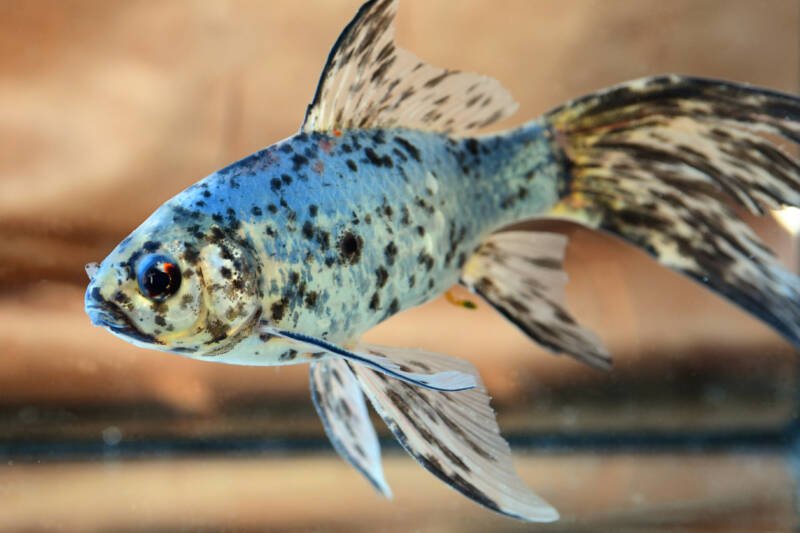
Size
Shubunkin goldfish adapt to the size of their environment. This is an evolutionary trait all goldfish share, allowing them to endure drought and overcrowding in the wild. It affects their growth, which often prompts the unaware to keep goldfish in bowls.
Bowls, vases, and other improperly small vessels result in poor goldfish health.
If you choose an appropriate aquarium size, though, you can expect your Shubunkin to grow to a length of 5-6 inches (13-15 cm).
In ponds, where Shubunkins have more freedom, they reach their full potential. You’ll see an adult length of 12-14 inches
(30-35,5 cm). Some fish may even grow up to 18 inches (46 cm) long, given the proper conditions!
Lifespan
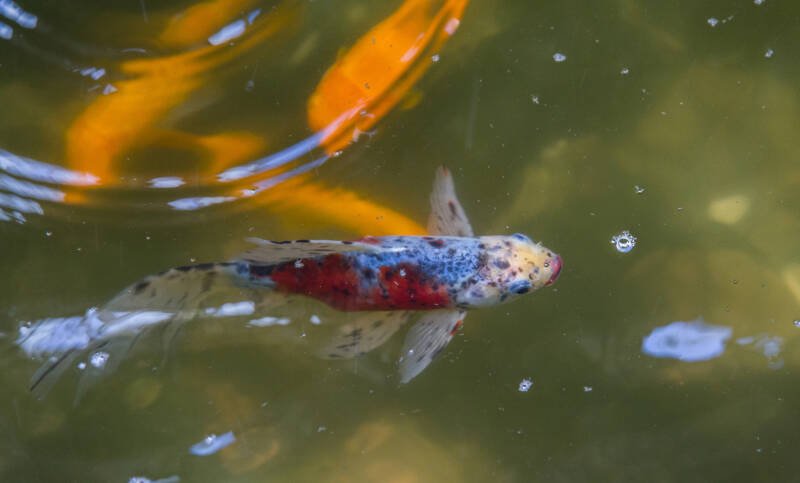
Despite the popular misconception of goldfish as temporary fish, Shubunkins live for an average of 10-15 years.
They require the proper tank size (or a pond), and you need to keep up with their water quality needs.
If you maintain pristine water, provide high-quality foods, and ensure adequate aquarium swimming space, you may see your Shubunkins survive up to 30 years! That’s an extreme estimate, but many last up to 20 years with excellent care.
Behavior
You CAN keep Shubunkins on their own, but they’re social fish. They don’t always shoal together, but they prefer the company of a school.
You need a minimum of two, but you MUST keep tank size in mind. A 75-gallon (284 l) tank will hold TWO Shubunkins – not more.
With voracious appetites, these quick goldfish often outcompete other fish in the aquarium. They also probe the bottom of the tank for missed scraps.
It means you can skip adding extra scavengers to the tank but keep an eye on slow-movers so they don’t starve.
Tank and Pond Setup
Remember, a healthy tank size STARTS at 75 gallons (284 l). Shubunkins are active swimmers, occupying all levels of the water column in their scavenging.
For each member you add to the school, you need to increase your tank by 10-15 gallons (38-57 l).
That need for wide-open spaces is why many people skip the tank and keep their Shubunkins in a pond instead.

Just make sure you provide proper coverage on the pond so your fish don’t end up as snacks for neighborhood predators.
You also need to cope with a high waste load. Similar to mollies, Shubunkins create a lot of mess. A filter with biological media makes the best choice, whether you have an aquarium OR keep a pond in your backyard.
The outflow from the filter provides all the water movement your Shubunkins require. Even wild goldfish don’t live in fast-moving rivers.
If you aren’t confident the filter’s enough, you can add an air stone for extra oxygen and water flow.
Water Conditions

Goldfish, in general, have a higher tolerance for water condition changes than more delicate tropical fish. It’s why they inhabit ponds so happily.
You still need to keep your water within a neutral pH, but that doesn’t require a lot of work.
Shubunkins CAN survive in water approaching freezing. It’s not ideal (a frozen pond decreases oxygen content), but these hardy fish are tough. They prefer a range closer to 65-72°F (18-22°C), but they’ll handle most winters.
You can keep your pond Shubunkins happier by providing a heater.
If your region freezes, install a deicer, so your Shubunkins have an airhole to go to. You’ll prevent a loss of oxygen, which is the greater concern.
Your Shubunkins can tolerate moderately soft water. They’d like a range between 5-19 dH.
They can tolerate nitrates under 40 ppm, but they’d prefer them below 20 ppm. Staying on top of those numbers will keep your fish healthier for longer.
Decorating the Shubunkin Pond or Tank
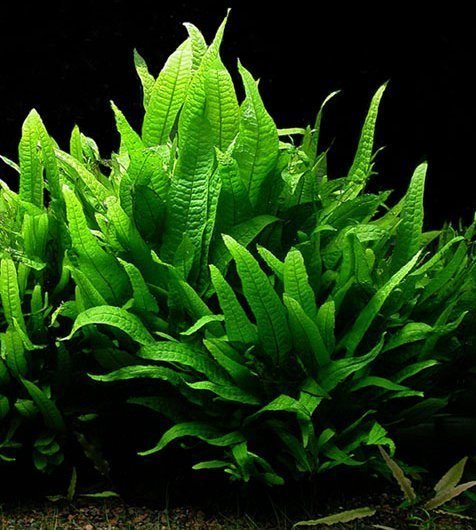
When it comes to decorations, Shubunkins aren’t picky. As a matter of fact, your little calicos are more likely to disturb your careful work than other fish. Their scavenging antics tend to uproot plants and lighter ornaments.
Some people opt for plastic or silk plants out of frustration. Your goldfish won’t have a preference, honestly.
However, if you want to provide some greenery as part of your Shubunkins’ diet, these tough plants can handle the abuse:
- Anacharis
- Hornwort
- Java fern.
Choose medium-sized gravel to prevent a cloud from forming in the tank water.
Sands will disperse into the tank with scavenging. Gravels allow your Shubunkins to probe for missed food without disturbing the clarity.
Rocks and driftwood make excellent choices for décor. Your Shubunkins shouldn’t be able to shift them easily. Just keep an eye on sizes – you don’t want to take over the swimming space your goldfish need.
Shubunkin Goldfish in Communities
Many aquarists combine Shubunkins with other goldfish.
Single-tailed goldfish swim fast and share the same bottomless stomachs, making them ideal tank mates. They also pair well in ponds.
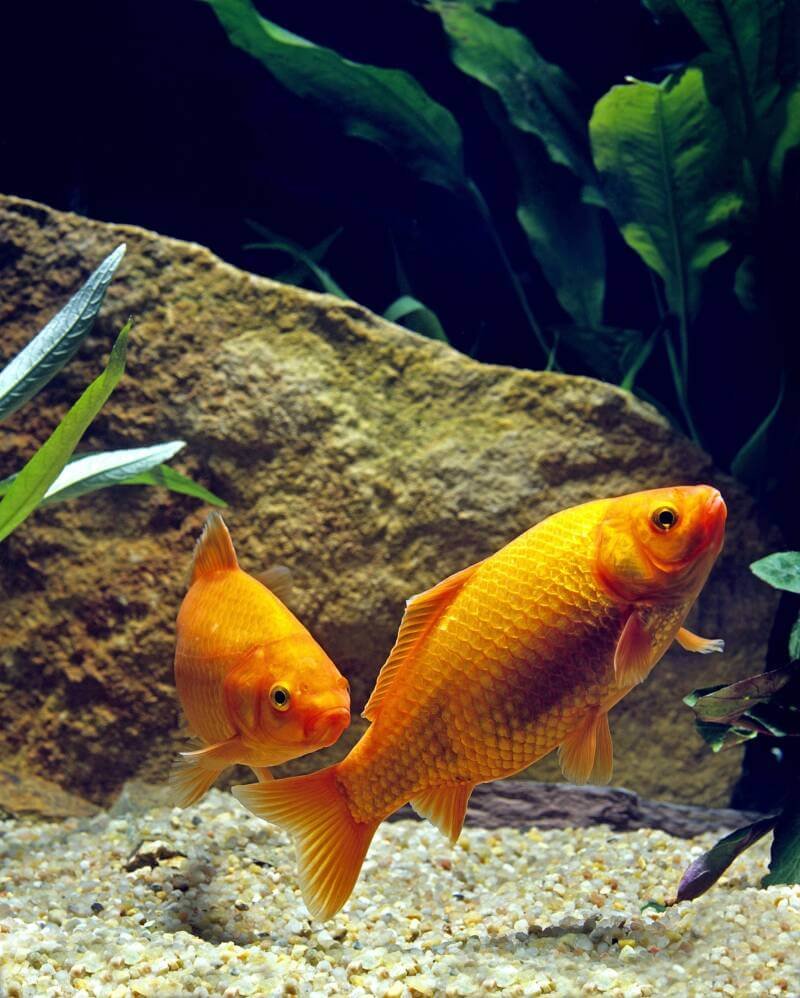
However, if you want to add your Shubunkins into a community tank, take care.
Tank Mates
Shubunkins are peaceful by nature. They just have no manners come mealtimes. So while they won’t harass other fish during the day, they WILL shove slower fish out of the way to get to the food.
You need to pair them with quick swimmers!
- Cherry barbs
- Chinese blue bitterlings
- Glass catfish
- Guppies
- Killifish
- Northern redbelly daces
- Tetras.
Incompatible Species
As you might expect, you need to avoid larger, more aggressive tank mates.
Cichlids and tiger barbs view Shubunkins as possible snacks. Unless you have a goldfish large enough to hold its own against these bullies, avoid combining them.
You also need to be careful when mixing Shubunkins and invertebrates.
Some freshwater shrimp, such as Amanos, are large enough to hold their own, but the tinier species can find themselves on the menu. You’ll want to use your common sense.
Feeding Your Shubunkin Goldfish
Goldfish – wild, captive, fancy, or common – are omnivores. They enjoy everything from plants to insects to leftovers wedged in the substrate. It makes them easy to feed, even for novice aquarists.
A base commercial food, such as Omega One Pellets, works well – whether you have a tank or pond. Just keep the food volume in check since they’ll eat until they pop.
An amount they can finish in two minutes is PLENTY.
Mix in high-quality proteins to provide them with sufficient swimming power. You can switch between fresh, frozen, and freeze-dried options, so your Shubunkins have a nice variety. Popular options include:
- Bloodworms
- Brine shrimp
- Krill.
And since you don’t want to keep replanting your pond or aquarium, make sure you add in plenty of healthy greens.
Shubunkins love to nibble on fruits and vegetables. You need to peel and blanch your offerings, but the following are popular goldfish favorites:
- Cucumber
- Lettuce
- Peas
- Orange
- Spinach
- Tomato
- Water hyacinth
- Watermelon.
Shubunkin Goldfish: Egg-Layers
If you provide the proper conditions, Shubunkins spawn without a problem.
You’ll need to set up a separate breeding tank, though. That means the same water conditions and plants or a spawning mop, so the eggs have somewhere to attach to.
A proper breeding group consists of at least 4-5 fish. Opt for the largest members of your school, as they’ll be the oldest and most mature of the group.
And make sure you have fry foods ready for when the eggs hatch.
Male or Female?
Sorting males from females at a young age is almost impossible. Males are slightly smaller and thinner than females, but the differences are subtle.
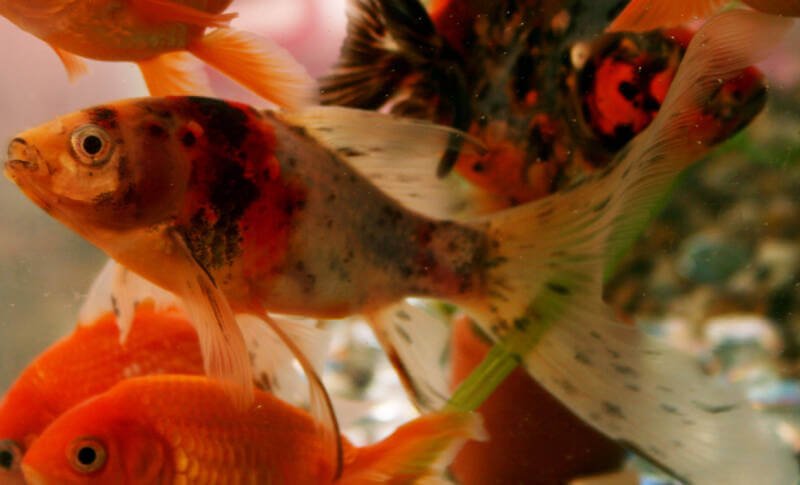
You’ll have to wait for breeding season and maturity to roll around to tell them apart (which is why you want the bigger fish).
During the breeding season, males develop breeding tubercles on their heads and gill covers. These appear as white spines.
The females gain rounder, fatter bellies as the eggs develop inside. Again, the larger your Shubunkins are, the easier these differences are to pick up.
Breeding
Shubunkin goldfish spawn during the spring months. To simulate that natural tendency, drop the breeding tank’s temperature to 60°F (15.5°C).
Over the next few days, increase the temperature by 3 degrees each day until you hit 72°F (22°C).
The males’ colors will brighten, and they’ll chase the females. Males then push females into the plants (or mops), stimulating them to release their eggs.
The males then follow behind, fertilizing the eggs. Females can lay up to 10,000 eggs at a time.
As soon as the spawning finishes, you MUST remove the adults from the breeding tank. The adults WILL eat the eggs.
Eggs hatch within 4-7 days and the fry spend a couple of days absorbing their egg sac. You can then feed them fry foods until they’re 1 inch (2.5 cm) long.
Health and Disease
Goldfish are hardy fish. However, they succumb to ich, the same as any other fish. The nasty parasite rears its head on Shubunkins, too.
You’ll notice your fish scratching against the tank walls and decorations, trying to scrape off the white spots.
Those white spots can spread, open, and invite further infection from the water’s bacteria if you don’t get immediate treatment.
Your Shubunkin will turn lethargic, and death CAN result. Don’t wait to intervene.
Shubunkins can also suffer from swim bladder disease. You’ll see your fish swimming sideways, trapped at the top or bottom of the tank, or swimming in strange patterns.
Different things cause swim bladder disease:
- Constipation
- Parasitic infection
- Physical deformities
- Poor nutrition.
Occasionally, you can correct swim bladder issues by feeding your Shubunkins blanched peas.
It’s not a guarantee, but starting with that simple therapy won’t hurt your goldfish. If it doesn’t work, definitely seek medical attention.
Shubunkin Goldfish: Are They for You?
Shubunkins make popular additions to indoor and outdoor aquariums.
Ranging in price from $3-$20, they rarely break the bank for most aquarists – even if you want a dramatic calico pattern.
They’re even used as a sign of good luck for newlyweds in some cultures.
Do you have Shubunkins? Do you keep them in a tank or a pond? What’s your preferred set-up?
Let us know your stories and questions here!